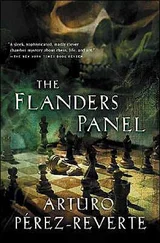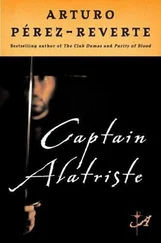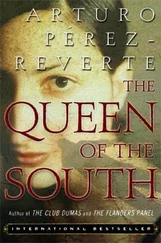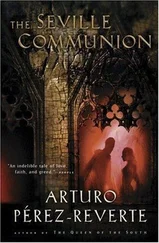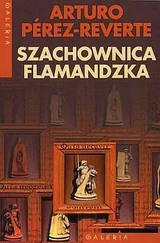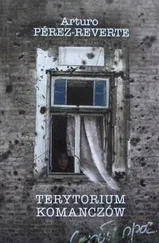Farther on, he began to encounter other travelers—a few muleteers on their way to Madrid—and near the Guadarrama River he overtook another mule-train transporting wineskins. At midday he crossed the Retamar bridge, where the bored guard simply pocketed the toll money without asking any questions or even demanding to see his face. From then on, the going was rougher and crag gier, with the path snaking through clumps of white broom, past ravines and rocks on which his horse’s hooves rang out as the path twisted and turned through a landscape which, thought Alatriste, studying it with a professional eye, would have been perfect for those gentlemen of the road, the highwaymen. However, one paid with one’s life for any crimes committed on the king’s lands, and such thieves preferred to carry out their trade a few leagues from there, robbing unwary travelers on the king’s highway that passed through Torre Lodones and past the Guadarrama River and into Old Castile. Reminding himself that highwaymen were not exactly his main concern, he checked that the primer was still dry in the pistol he had hung on the saddle-tree, within easy reach.
9. THE SWORD AND THE DAGGER
I must confess to feeling terrified, and with good reason. The Count of Guadalmedina in person had sought me out, and now we were striding along together beneath the arches of El Escorial’s main courtyard. I had been in don Francisco de Quevedo’s room, engaged in making a fair copy of some lines from his new play, when Guadalmedina appeared at the door, and Quevedo barely had time to shoot me a somber, cautionary glance before the count ordered me to follow him. The count’s elegant cape, which he wore draped over his left shoulder, swayed as he strode angrily ahead of me, his left hand on the hilt of his sword and his impatient footsteps echoing along that eastern side of the courtyard. We passed the guard, went up the small staircase adjoining the royal tennis court, and emerged onto the upper floor.
“Wait here,” he said.
I did as I was told, and he disappeared through a door. I was standing in a dreary hallway of gray granite, no tapestries, paintings, or any other ornament in evidence, and all that cold stone made me shiver. I shivered still more when the count reappeared and ordered me curtly to come in, for I found myself entering a long gallery with a painted ceiling and walls adorned with frescoes depicting scenes of war. The only furniture was a chair and a table containing writing implements. Along one wall there were nine windows that opened onto an inner courtyard, and the light from these windows lit up the fresco on the opposite wall, which showed Christian knights fighting Moors and recorded the battle in all its military detail. This was the first time I had entered the Hall of Battles, and I was far from imagining then that, in time, those paintings commemorating the victory at Higueruela, the battle of San Quintín, and the attack on the Azores would be as familiar to me as the rest of the royal palace when, years later, I was made lieutenant and then captain of King Philip IV’s guard. At that moment, however, the Íñigo Balboa walking beside the Count of Guadalmedina was merely a frightened boy, incapable of appreciating the magnificent paintings decorating the gallery. My five senses were all focused on the imposing figure waiting at the far end, next to the last of the nine windows. He was a heavily built man, with a thick, closely trimmed beard and a fearsome mustache that grew bushier at the ends. He was wearing a costume made of brown lamé with the green cross of Alcántara on his breast, and his large, powerful head sat on a thick neck barely contained by a starched ruff. As I approached, he fixed me with his dark, intelligent eyes, as threatening as two harquebuses; and at the time I am describing, those eyes could send a shudder of fear throughout the whole of Europe.
“This is the boy,” said Guadalmedina.
The count-duke, His Catholic Majesty’s favorite and adviser, nodded almost imperceptibly, without taking his eyes off me. In one hand he was holding a piece of paper, and in the other a cup of thick, hot chocolate.
“When is this Alatriste fellow supposed to arrive?” he asked Guadalmedina.
“At sunset, I believe. He has instructions to present himself here as soon as possible.”
Olivares leaned slightly toward me. Hearing him say my master’s name had left me speechless.
“Are you Íñigo Balboa?”
I nodded, incapable of uttering a word, while I struggled to put my thoughts in order. In between sips of chocolate, the count-duke was reading aloud from the piece of paper he was holding: “. . . born in Oñate, Guipúzcoa, the son of a soldier who died in Flanders, servant to Diego Alatriste y Tenorio, better known as Captain Alatriste, et cetera. A soldier’s page in the old Cartagena regiment. Present at the taking of Oudkerk, at the battles of Ruyter Mill and Terheyden, the siege of Breda . . .” After each Flemish name, he glanced up as if to compare the fact with my evident youth. “And before that, there had been an auto-da-fé in the Plaza Mayor in Madrid, in sixteen hundred and twenty-three.
“Ah, yes, I remember now,” he said, looking at me more attentively now, meanwhile putting his cup down on the table. “Some business with the Holy Office of the Inquisition.”
It was not at all reassuring to know that one’s biography was so precisely documented, and the memory of my brush with the Inquisition did nothing to calm my spirits. However, the question that followed transformed my bewilderment into panic.
“What happened in Camino de las Minillas?”
I looked at Álvaro de la Marca, who nodded reassuringly.
“You can speak openly to His Excellency,” he said. “He is fully informed.”
I continued to eye him suspiciously. When we met in Juan Vicuña’s gambling den, I had described to him the events of that ill-starred night on condition that he told no one until Captain Alatriste had spoken to him. The captain had not yet arrived; Guadalmedina, who was, after all, a courtier, had not played fair. Or perhaps he was merely covering his back.
“I don’t know anything about the captain,” I stammered.
“Don’t be ridiculous,” said Guadalmedina. “You were there with him and with the man who died. Tell His Excellency exactly what happened.”
I turned to the count-duke. He was still observing me with alarming fixity. That man bore on his shoulders the most powerful monarchy on earth; he could move whole armies across seas and mountains just by lifting an eyebrow. And there was I, trembling inside like a leaf and about to tell him no.
“No,” I said.
The count-duke blinked.
“Have you gone mad?” exclaimed Guadalmedina.
The count-duke still did not take his eyes off me, although his gaze seemed more curious now than angry.
“By my life, I’ll . . .” began Guadalmedina threateningly, taking a step toward me.
Olivares stopped him by making the very slightest of movements with his left hand. Then he glanced back at the piece of paper and folded it in four before putting it away.
“Why not?” he asked me.
He did so almost gently. I looked across at the windows and chimneys on the far side of the courtyard, at the blue-gray slate tiles lit by the setting sun. Then I shrugged my shoulders and said nothing.
“Ye gods,” said Guadalmedina, “I’ll make you loosen that tongue of yours.”
The count-duke again brought him up short, with that same slight gesture. He seemed to be able to see into every corner of my mind.
“He is, of course, your friend,” he said at last.
I nodded. After a moment, the count-duke nodded too.
“I understand,” he said.
He took a few steps about the gallery, stopping by a fresco that showed ranks of Spanish infantry, bristling with pikes, all grouped around the cross of San Andrés, marching toward the enemy. Sword in hand, smeared with gunpowder, hoarse with shouting out the name of Spain, I, too, had once belonged to those ranks, I thought bitterly, as had Captain Alatriste. Despite that, there we were. I noticed that the count-duke saw that I was looking at the scene and read my thoughts. The hint of a smile softened his features.
Читать дальше

